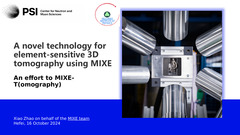A novel technology for element-sensitive 3D tomography
ID:32
Submission ID:32 View Protection:ATTENDEE
Updated Time:2024-08-28 15:02:09
Hits:598
Oral Presentation
Abstract
Muon Induced X-ray Emission (MIXE) [1] is an advanced non-destructive technique that utilizes muons to analyze the elemental composition within materials. This method is particularly valuable in fields requiring non-destructive structural analysis, such as archaeology, battery research, meteoritics, environmental science, geology and mechanical engineering. The use of the high-rate continuous muon beam at the Paul Scherrer Institute (PSI) has facilitated significant advancements in MIXE technology[2].
To advance the technique towards a universal tomographic method, additional tracking information from incoming muons was employed. This configuration facilitates layer-by-layer scanning of samples, establishing it as the most advanced technique for element-sensitive 3D tomography. To this end, a Twin GEM-TPC (Gas Electron Multiplier based Time Projection Chamber) tracker, initially developed for heavy-ion tracking at FAIR[3], was evaluated and characterized in collaboration with the RD51 collaboration at CERN and the University of Helsinki.
An independent small fiber detector was constructed and used successfully to calibrate the drift time for both GEM-TPC chambers with high precision. The initial proof-of-principle measurements during the 2023 campaign demonstrated the capability of the combined MIXE and tracker setup for element-sensitive imaging with resolutions on the order of 1 mm.
However, the detector initially faced limitations due to multiple scattering in high-density gas (Ar/CO2) mixtures, restricting it to relatively high muon momenta (p $\geq$ 45 MeV/c). To minimize the scattering effect, a gas mixture of helium as the sensitive material and CO2 as the quencher replaced the previous Ar/CO2 mixture, and finally we choose a He/CO2 ratio of 90:10. This adjustment allows for probing the samples at lower muon momenta, closer to the material surface, and enhances spatial resolution. The new prototype, evaluated during the 2024 campaign, demonstrated that we are among the few groups to successfully operate a GEM-based TPC stably with such a gas mixture.
Addtionally, with the new prototype, the samples can be tested at muon momenta down to $\sim$ 25 MeV/c, while initial results still showing robust imaging capabilities.
For the first time, the combined use of MIXE and low-density gas TPC technologies has realized world-leading, element-sensitive 3D tomography. This report will present the current progress and latest results. Future efforts will further extend the applicability of this technology across diverse fields by upgrading the tracker's performance and increasing detection sensitivity.
[1] Reidy, J.J.; Hutson, R.L.; Daniel, H.; Springer, K. Use of muonic X-rays for nondestructive analysis of bulk samples for low Z constituents. Anal. Chem. 1978, 50, 40–44.
[2] Biswas, S., Megatli-Niebel, I., Raselli, L. et al. The non-destructive investigation of a late antique knob bow fibula (Bugelknopffibel) from Kaiseraugst/CH using Muon Induced X-ray Emission (MIXE). Herit Sci 11, 43 (2023). https://doi.org/10.1186/s40494-023-00880-0
[3] F. Garcia, et al, A GEM-TPC in twin configuration for the Super-FRS tracking of heavy ions at FAIR, Nuclear Instruments and Methods in Physics Research Section A:Accelerators, Spectrometers, Detectors and Associated Equipment, Volume 884, 2018,
Pages 18-24, ISSN 0168-9002, https://doi.org/10.1016/j.nima.2017.11.088
Keywords
Non-destructive 3D tomography; GEM-TPC; MIXE
Submission Author
Xiao Zhao
PSI
Michael Heiss
PSI
Francisco Garcia
University of Helsinki;CERN
Bernhard Josef Zeh
PSI;ETH zurich
Karl Jonathan Flöthner
CERN;University of Bonn
Gianluca Janka
PSI
Lucian Scharenberg
CERN
Benjamin Banto Oberhauser
ETH zurich
Hans Müller
CERN
Sayani Biswas
PSI;ISIS
Thomas Prokscha
PSI
Eraldo Oliveri
CERN
Alex Amato
PSI




Comment submit